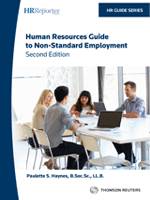Human Resources Guide to Non-Standard Employment, Second Edition
Haynes, Paulette S.
Éditeur : CANADA LAW BOOK
ISBN papier: 9780779873029
Parution : 2019
Code produit : 1382108
Catégorisation :
Livres /
Gestion /
Gestion des ressources humaines /
Organisation du travail
Formats disponibles
| Format | Qté. disp. | Prix* | Commander |
|---|---|---|---|
| Livre papier | En rupture de stock** |
Prix membre : 72,20 $ Prix non-membre : 76,00 $ |
*Les prix sont en dollars canadien. Taxes et frais de livraison en sus.
**Ce produits est en rupture de stock mais sera expédié dès qu'ils sera disponible.
Description
The workplace of the 21st century will not be characterized predominantly by permanent, full-time employment with job security, regular hours and benefits. Indeed, today’s trend towards non-standard employment is likely to create a workplace where contingent employment will become the norm in the relatively near future. An increasing number of employers are using some form of non-traditional staffing arrangements to assist them in meeting the demands of their organizations and their workers. While this much needed flexibility frequently benefits employers, managing a contingent workforce poses some interesting issues and challenges from both legal and practical perspectives. For many workers, non-standard work provides a means of flexibility in the face of family responsibilities, school and other obligations. But, for other workers, the reality is that non-traditional employment is a matter of necessity in an environment where full-time work is becoming increasingly scarce. Workers and employers need to adapt to the changing realities of the new economy and will increasingly be required to work together to develop creative solutions that capitalize on the increased flexibility and convenience afforded by modern technology while seeking to provide workers with a decent living, retaining a degree of organizational commitment and maintaining employee engagement. Human Resources Guide to Non-Standard Employment, Second Edition is intended to provide employers with a guide to understanding the various types of non-standard work arrangements and employers’ obligations towards such workers. It provides a legal and practical overview of the rights and obligations afforded to non-standard employees and independent contractors. Topics covered include benefits, pensions, employment legislation and workers' compensation. There is also a discussion relating to the following issues: wrongful dismissal; employment contracts; non-traditional workers and employment standards entitlement; part-time workers and terms of employment; job-sharing; and contract workers and legal remedies for breach of contract. New updates for the second edition include: •Information on recent legislation and case law developments relating to non-standard workers (including casual, seasonal and fixed-term employees, independent and dependent contractors, agency workers, freelancers, piece workers and temporary foreign workers), technology use in the workplace and the impact of privacy legislation; •Updated discussions on technology and best practices in the non-standard work environment (including remote work and telecommuting, the use of mobile devices and social media); •Current trends and predictions about the future of non-standard work, including the rise of freelancing and concepts such as “micro-entrepreneurship,” the “gig economy” and the “sharing economy;” •New tools and templates including a checklist and several sample policies designed to be used and modified in your own organization























